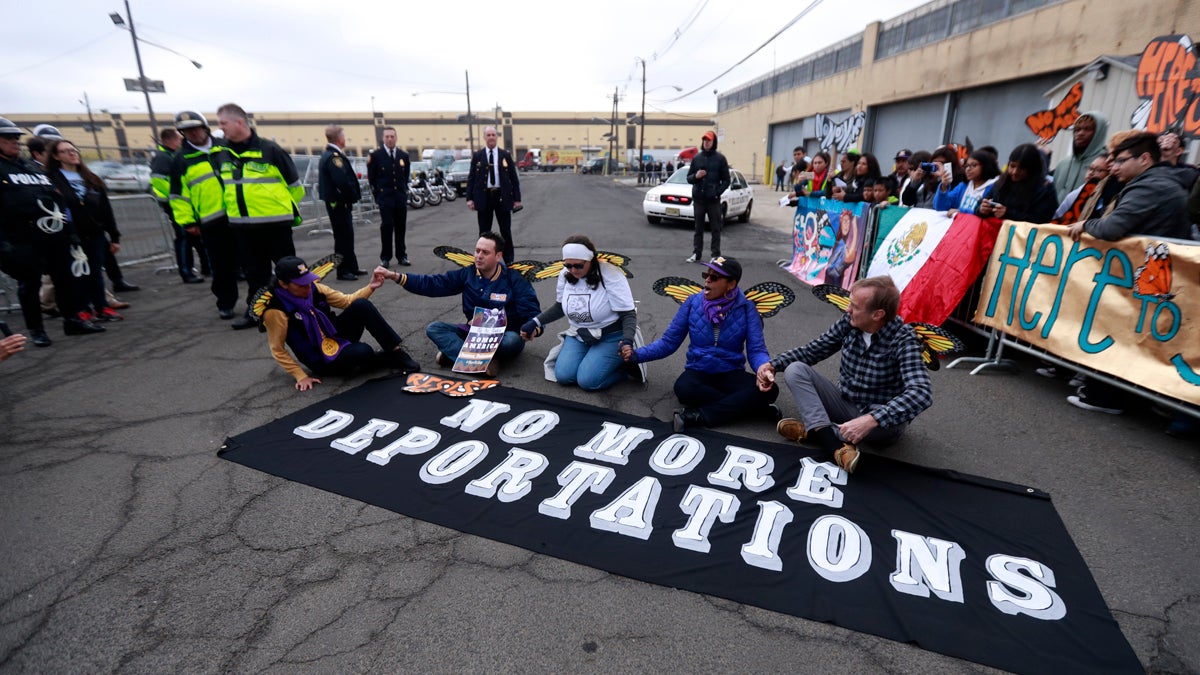Immigration crackdown reaches deep into New Jersey communities

Activists block a street as police officers look on during an immigration protest outside of a detention center, Thursday, Feb. 23, 2017, in Elizabeth, N.J. (Julio Cortez/AP Photo)
New data reveals that more than 90 percent of the state’s municipalities have cases pending in immigration court, the fifth-largest caseload in the country.
The United States’ immigration crackdown reaches far beyond typical immigrant enclaves: More than 31,000 people from every New Jersey county and more than 90 percent of municipalities have cases pending in immigration court, new data shows.
New Jersey has the fifth-largest immigration court caseload in the nation, according to data from the Transactional Records Access Clearinghouse at Syracuse University. TRAC’s Immigration Project gathers detailed, up-to-date data and makes it available to the public. It recently created a web-mapping application that, for the first time, provides counts of those with pending cases according to their county and municipality of residence.
The new data shows that more than three in four counties nationwide have active cases. In New Jersey, people in every county are in court, with the numbers ranging from 57 in the northernmost Sussex County to 4,950 in urban Essex. At least one person in 510 of the state’s municipalities — more than nine of every 10 — have cases pending.
TRAC researchers found “some surprising facts” when examining the data, according to a press release issued by the clearinghouse. “There are a very large number of communities across the country that now have residents with cases before the Immigration Court.”
The long reach of Homeland Security
The data shows that the reach of the U.S. Department of Homeland Security, which charges individuals with violating immigration laws, extends into the suburbs and rural areas and into small towns as well as big cities. Cities do have the largest number of cases nationwide and in New Jersey. Houston, alone, has 33,360 cases, more than the entire state of New Jersey.
Here, people living in Newark represent the largest proportion in the immigration courts, numbering 3,151. That puts Newark among the 20 communities with the largest number of cases in the country. Elizabeth, Plainfield, and Trenton each have more than 1,000 people with immigration court cases, although Elizabeth’s number could be slightly overstated because people held at the Elizabeth Detention Center would be counted as city residents.
Not all these cases are due to the Trump administration crackdown on all undocumented immigrants, including those without any criminal convictions, those who have lived in the United States for a decade or more, and those with parents or children here. Less than 7 percent of all New Jersey cases, or 2,070, were filed within the prior 90 days. It takes an average of 819 days, or 2 ¼ years, for a case in New Jersey’s immigration courts to be concluded.
Ratcheting up enforcement
In January, President Donald Trump issued an executive order ratcheting up immigration enforcement through policies designed to stem illegal immigration and more aggressively find, apprehend, detain, and remove those who entered or stayed in the country improperly.
Advocates say Trump’s order has significantly changed the landscape of immigration enforcement. “Arrests are up so far under the new administration, as are the noncriminal share of arrests and share of final decisions resulting in removal, while deportations are down,” said Michelle Mittelstadt, director of communications and public affairs for the Migration Policy Institute, a nonpartisan think tank in Washington, D.C., that examines and analyzes immigration and related issues. “Because deportations can take so long to wend their way through the system amid huge court backlogs, the deportation picture is not really one that can be assessed solely for this administration at this point because many of these cases were initiated earlier.”
Arrests by U.S. Immigration and Customs Enforcement officials increased by more than a third in the first nine months of this fiscal year, compared with the same period in 2016, and more than a quarter of arrests were noncriminal, an increase of nearly 150 percent and occurring nationwide. At that pace, Mittelstadt said, ICE arrests are likely to reach about 150,000, which is more than in recent years but less than in the period of 2008 through 2011, when ICE was arresting more than 250,000 annually.
While the number of people actually leaving the country due to deportation or voluntary departure is down, the percent of decisions resulting in deportations has risen so far this fiscal year, for the first time in nine years. More than half of the cases decided nationally this year have ended in deportation.
Deportations down
That percentage was significantly lower in New Jersey, where just 42.8 percent of cases ended with deportation rulings. That means 1,719 immigrants with cases heard in the New Jersey immigration courts were ordered to leave or agreed to depart the country through the end of June, while 2,301 were allowed to stay.
The Department of Justice last week touted the national increases in removal orders and final decisions issued by immigration judges in a press release that proclaimed a “Return to Rule of Law in Trump Administration.”
What’s different is that the Trump administration has virtually eliminated the use of discretion to close cases, while President Barack Obama had encouraged ICE attorneys to use prosecutorial discretion to close certain cases: for instance, when an immigrant had extensive ties to the United States and was not considered a priority because of having a significant criminal conviction or prior deportation order. According to TRAC, ICE used discretion to close fewer than 100 cases a month on average during Trump’s first six months in office, compared with the average of 2,400 closed each month during Obama’s last term.
“We are seeing a more indiscriminate approach to ICE enforcement,” said Farrin Anello, a fellow at the ACLU Immigrants Rights Project and a director of the Refugee Reunification Project Fund. “ICE has long arrested people who have no criminal history, as well as people with very low-level, nonviolent offenses, and people who have lived here since they were children, and who now have U.S. citizen children of their own. But the prior administration created a set of priorities to try to focus ICE resources on cases deemed more serious. The current administration has abandoned the idea of enforcement priorities.”
Anello said ICE is also now targeting the parents and other family members of children who came to the United States on their own. The government undertakes removal proceedings on unaccompanied children even though most are fleeing gang violence or domestic abuse and have strong claims for asylum or a special visa.
Targeting parents and children
“To ensure that these children could find a safe place to live while here in the United States, the government used to ensure that parents or other family members who came forward to care for them could do so safely, regardless of their immigration status,” Anello continued. “Now, ICE is specifically targeting parents and family members of arriving children for deportation, and the administration has announced it will be investigating parents or guardians for possible criminal prosecutions, based upon their efforts to bring their children to safety. This policy affects not only those family members, but also the children, who are likely to find themselves in foster care, group homes, or unsafe situations when parents and family cannot come forward to care for them.”
According to TRAC, about 4,806 people faced new deportation proceedings in New Jersey immigration courts through the end of June this fiscal year. About 80 percent came from 10 Latin American countries, led by Mexico, with 1,135 nationals facing deportation. By contrast, about 45 percent of the estimated 1.9 million foreign born in New Jersey, including estimates of the undocumented, were born in Latin America, according to the U.S. Census Bureau. The Migration Policy Institute estimates New Jersey has nearly 500,000 undocumented immigrants, with 20 percent of those coming from Mexico.
Of those with a new deportation case this year, only 318, or fewer than 7 percent, were in court because they were charged with or convicted of significant crimes.
WHYY is your source for fact-based, in-depth journalism and information. As a nonprofit organization, we rely on financial support from readers like you. Please give today.




